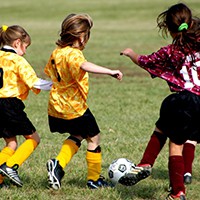Last updated: August 25 2015
Child Fitness Amount: Small Improvements but Welcome Relief

Our sons participated with gusto in many sports: hockey, lacrosse, soccer and marathon running. In the chief role of road warriors, we charioted cherubs from one sportsplex to another. These activities provided physical, social, team and leadership skills that continue to be priceless, despite the often exorbitant price tag.
Today, parents who can find the time to save receipts for all these activities, and retrieve them at tax time, have financial help: a new refundable tax credit can help defray the costs.
The Children’s Fitness Amount recognizes eligible expenses for sports and fitness activities taken by each child under age 16. It’s been around since 2007, structured as a non-refundable tax credit that reduces federal taxes payable, but it has recently been enhanced. In tax year 2014, the maximum credit was doubled to $1,000, and parents of a disabled child under 18 could claim up to $500 more if they spent at least $100 on the activity.
Better news: starting in tax year 2015, the Children’s Fitness Amount is a refundable credit. This means that lower-income taxpayers who could not benefit from a non-refundable credit in the past, because they paid no taxes, will be able to receive a cash refund on a portion of the costs, simply by filing a tax return.
 What qualifies? The activities must develop cardiorespiratory endurance as well as at least one or more of muscular strength, endurance, flexibility or balance. Some interesting activities qualify so be sure to save all the receipts for sailing, horseback riding, bowling and golf lessons, for example, in addition to the more typical hockey and soccer. Fees for extra-curricular school activities qualify too.
What qualifies? The activities must develop cardiorespiratory endurance as well as at least one or more of muscular strength, endurance, flexibility or balance. Some interesting activities qualify so be sure to save all the receipts for sailing, horseback riding, bowling and golf lessons, for example, in addition to the more typical hockey and soccer. Fees for extra-curricular school activities qualify too.
What doesn’t? Any unsupervised activities, or activities that are a part of a regular school program or a sports-academics program are not eligible. Any activities that involve riding in or on a motorized vehicle as an essential component are out; so are costs of travel, room and board at a fitness camp or other accommodation, food or beverages.
How much can you claim for the Children’s Fitness Amount? You’ll save 15% of every dollar you fork out, up to the maximum limits above. That’s a maximum of up to $150 for each healthy child.
Who can claim it? Spouses, including common-law spouses, can share the claim. Unfortunately grandparents can’t.
Still, that’s no reason not to share the sports agenda with all the generations in the family, as well as the driving activities, and embellish the cheering section. Junior’s sporting achievements are a great opportunity for family celebration, good natured back-slapping and infectious joy. Have fun, fellow road warriors!
Evelyn Jacks is President of Knowledge Bureau, a national educational institute for the continuing education of professional advisors. She is currently writing her 52nd book, Family Tax Essentials, from which this article is a sneak peek.
